Calvados in Normandy: Tales from the Parisian Riviera
Famous for its cider and its eponymously named eau-de-vie, this is William the Conqueror’s birthplace and where the Allies landed in 1944. Marion Sauvebois discovers a département where the locals have become the self-appointed custodians of important history
Looming behind the seawall at Bernières-sur-Mer, La Maison des Canadiens, the first house liberated on Juno Beach on D-Day, comes into view. I start to edge closer on the eerily silent coast, trying but failing to picture the scrum of Canadian troops wading onto shore against a hail of German bullets fired from this very porch, when a blur of movement in the bay window catches the corner of my eye. Half-concealed by heavy drapes, a diminutive figure is waving eagerly, beckoning us in.
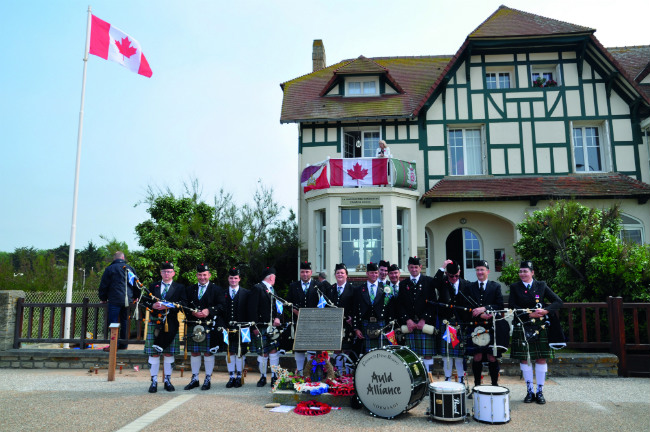
The Canadian delegation at the D-Day festival, Bernières-sur-Mer
“It’s Madame Hoffer,” explains our guide, pointing at her watch and mouthing an apology in her direction. But Mme Hoffer is having none of it, signalling some more before throwing the door wide open. And in we all file, to our genial host’s effusive greetings. We’re in luck, she exclaims, she doesn’t usually stay at her “beach house” at this time of year. Museum seems a more accurate description as we poke our heads into the living room and stare goggle-eyed at the pell-mell of militaria, Canadian flags, regimental insignia and uniforms shoehorned between furniture.
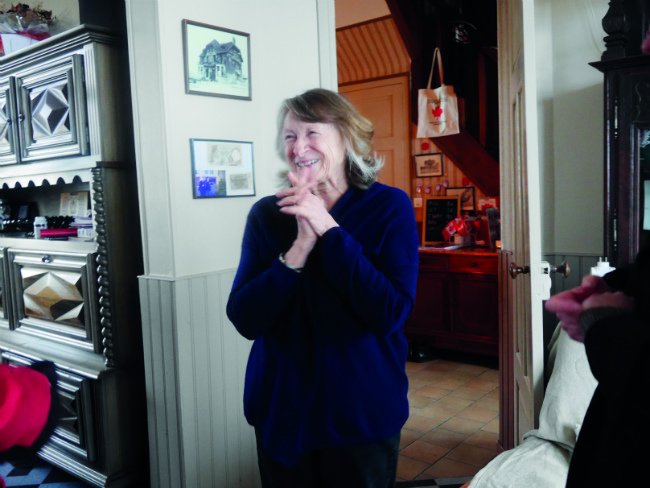
Madame Hoffer, whose house has gradually become a museum. Photo: Marion Sauvebois
Unfazed, Mme Hoffer lls our stunned silence with the lengthy inventory of the priceless mementoes which have made their way into her summer home, scooching past the sideboard and pushing a chair to show off a particular map or photograph. She pauses in the doorway, motioning to a framed, bloodstained 500-franc note: a bribe from a German to a Canadian soldier in exchange for his life. The veteran, like many others over the years, donated it unbidden to Mme Hoffer and her late husband during a pilgrimage to Juno – incidentally, the most overlooked of the landing beaches – until they had amassed such a collection that their second home had become a makeshift memorial of sorts.
Her voice drops to a whisper as she confesses she and her husband hadn’t had the foggiest about the villa’s strategic role in Operation Overlord until well into the 1980s. Spying curious swathes of walkers lurking by, or brazenly leaning over their fence, they “lured them in with some Calva” and eventually discovered their ancestral home had not only been used as a position landmark by the 14,000 dauntless men who reshaped the course of history on Calvados’s shores but the first liberated by the Queen’s Own Rifles of Canada at 8.15 am on June 6, 1944. Without quite knowing how, they had been appointed custodians of this unexpected legacy.

Turn-of-the-century beach houses show the area’s heritage as a seaside resort. Photo: Hervé Sentucq
They spent the following decades piecing together this untold history by gathering testimonies and beckoning all and sundry into La Maison des Canadiens. The promise of a tipple was not always enough, however. “One veteran was looking round the garden once and I invited him in but he refused,” she recalls. “He explained that on D-Day he had thrown grenades down into the cellar to smoke Germans out. He said he would not be held accountable for any historic damage to the house.” She chuckles softly, her eyes sweeping the jumble of memorabilia. “It’s my devoir de mémoire (duty of memory),” she shrugs. “Someone has to keep the past alive.”
This devoir de mémoire, I would soon discover, is part and parcel of the Calvadosien philosophy. A veritable time capsule – from the vestiges of WWII peppering the Côte de Nacre at Omaha, Gold, Sword and indeed Juno, to the endless markers of William the Conqueror’s rule and the florid villas of the Côte Fleurie – the département where the fate of the free world was sealed is one great open-air museum; and every last denizen its self-appointed curator.
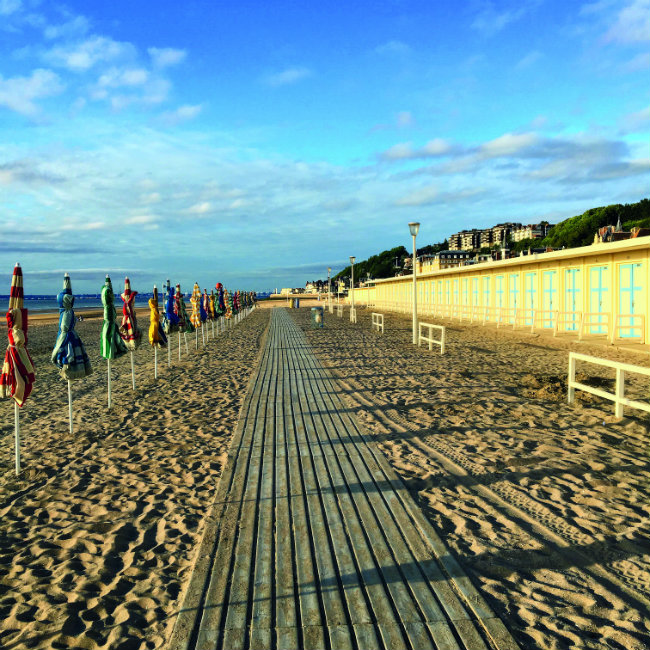
The famous boardwalk on Trouville beach. Photo: Office de Tourisme
IN GUILLAUME’S FOOTSTEPS
You can’t accuse Calvadosiens of having a cavalier attitude towards their past, no matter how distant. There is a distinct sense of ownership in the locals’ peculiar habit of referring to William the Conqueror (Guillaume le Conquérant) as plain old Guillaume, as though he were just another village lad. After three days in these parts, I had become so used to hearing his Christian name bandied about, I half expected Will to canter past en route to Hastings.
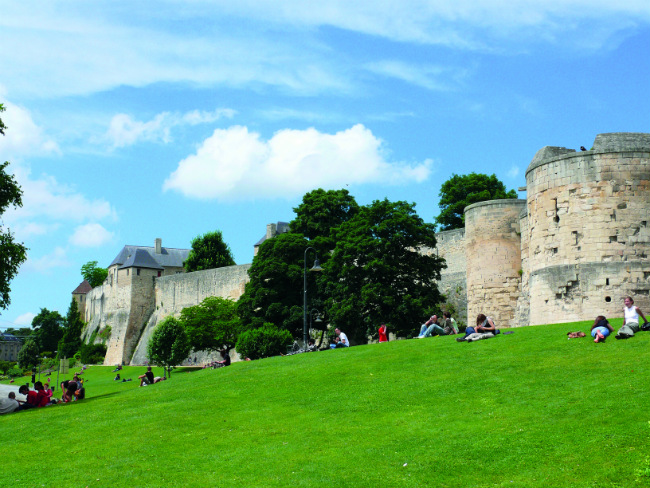
The Caen Chateau ©L. DURAND/ CALVADOS
That said, the hands-on approach to heritage can be a tad tricky to wrap one’s head around at times. I shan’t forget in a hurry the sight of the kind soul at the tourist office in Dives-sur-Mer, the port town William and his fleet set sail from to claim the throne of England, tugging vigorously at the 600-year-old side-door to the historic 15th-century market hall until it gave way. Did I mention she’d picked up the spare key from the café next door? It was certainly worth the forceful entry, though I did breathe a sigh of relief when our next stop – the honey-stoned Notre-Dame Church, whose pediment bears the names of William’s 475 companions – was unlocked… But let’s get back to Calvados’s poster-boy and friend to all, Guillaume.
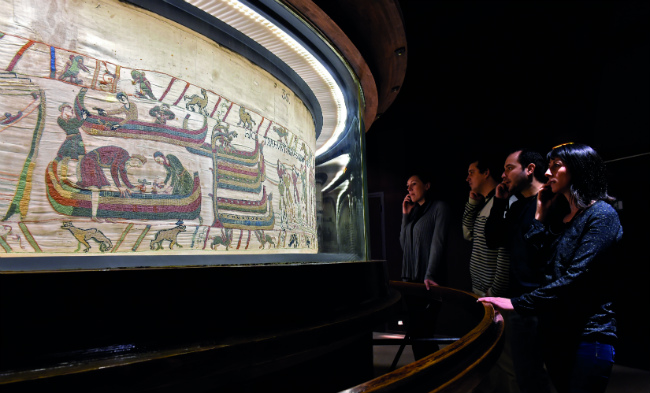
The Bayeux tapestry. Photo: Bayeux Museum
You can’t take one step in Calvados without stumbling across a hamlet he scratched his derrière in. Born in Falaise, the illegitimate son of Robert the Magnificent and a tanner’s daughter, he was known as ‘William the Bastard’ until his victory at Hastings and subsequent ascent to the English throne earned him the ‘Conqueror’ upgrade. His exploits are immortalised in the intricate Bayeux Tapestry (technically an embroidery) displayed in the town of the same name. The 70-metre-long stitched epic of the Norman Conquest of 1066 is a mind-boggling work of vivid and graphic battle scenes and bloodshed, spurting gashes and all – though some of the deeper shades of puce in the final tableaux are (and at this the the museum’s press officer sighs audibly) “the result of a questionable 19th- century restoration”.
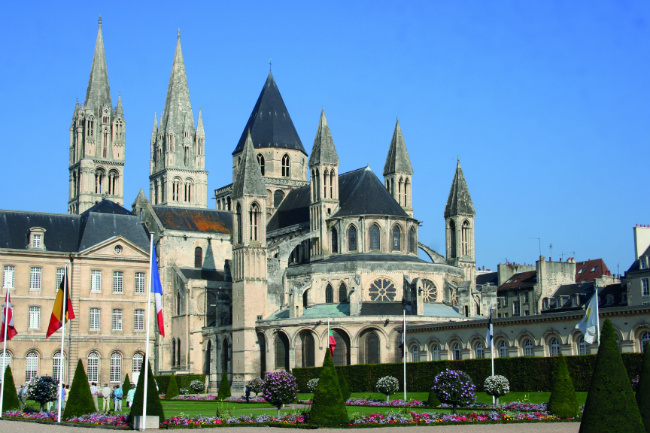
In Caen, the Abbaye aux Hommes is the final resting place of William the Conqueror. © L DURAND/ OT CALVADOS
Precious little is known about its inception, though it’s believed to have been commissioned by William’s half-brother Odo and likely embroidered in England circa 1077 – and not, as legend would have it, hand-stitched by a pining Queen Matilda, Penelope-style, awaiting her victor’s return. As can be expected, as we roll into town the news that the tapestry may be loaned to the UK is all anyone can talk about. Apparently, a blabbermouth at Westminster (accidentally?) tipped off The Times a smidgen early, throwing this quiet Norman nook into a spin and sparking heated debate about the practicalities and perils of moving such a delicate artwork. But these “alarmist speculations” are quickly brushed off by our sanguine escort who, to my sheer amazement, launches into the play-by-play of how only two years ago she, along with 49 of her dearest colleagues, chipped in to shift (ever so carefully, she points out) the cloth along railings production-line style to have it digitised. Quite the hands-on approach to heritage, indeed.
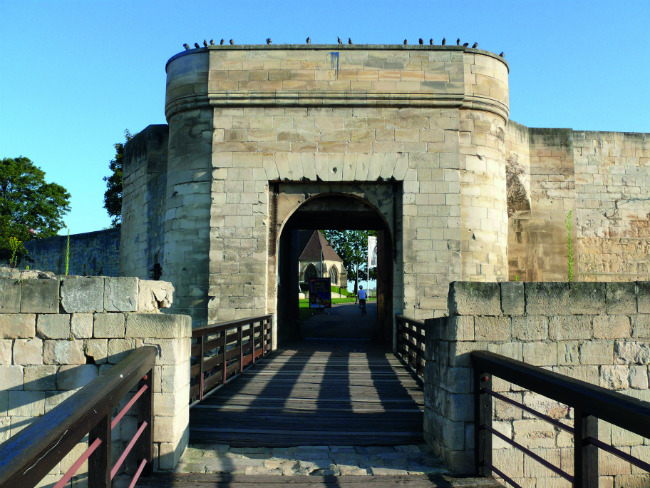
The Caen Chateau. © L DURAND/ OT CALVADOS
No jaunt to William’s stomping ground is quite complete without a good old recce to the motherlode: Caen, once the seat of his duchy – and a triumph of post-war reconstruction with street-art cred too. Despite relentless Allied bombings that all but razed the city, its precious holy trinity – William’s Ducal castle and the twin Abbaye aux Hommes and Abbaye aux Dames – were miraculously spared. Erected as bargaining tools, the abbeys were intended to appease the Pope, who opposed William’s marriage to Matilda.
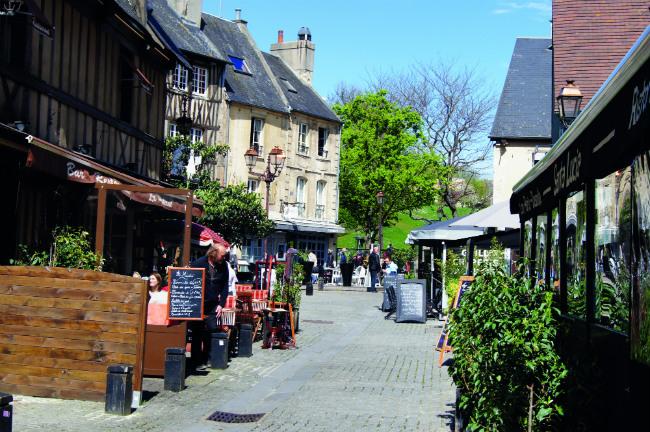
The Quartier du Vaugueux in Caen. ©L. DECHAMPS/ CALVADOS
The glorious Norman Romanesque monasteries did the trick and are now the final resting place of William (his femur anyway) and Matilda respectively. It seems that in William’s case the burial proved problematic. “He was abnormally tall for the time and pretty large at the end, and didn’t t in the coffin,” our ever-helpful escort pipes up. “In fact the story goes that they had to force the body in as best they could. His belly exploded and the stench was so bad the ceremony had to be cut short,” she concludes blithely, the incongruity of this stomach-churning nugget in our solemn locale – not to mention our obvious shock – seemingly lost on her (though her ear-to-ear grin tells a different story). Stifling a guilty guffaw, I try to push images of guts shooting over the altar out of my mind, throwing a sideways glance at the rows of, thankfully vacant, pews behind us.
Calvadosiens’ fondness for shock tactics, I was about to realise as I delved into the bracing history of its coastal resorts’ ‘human cannonballs’, runs deep.
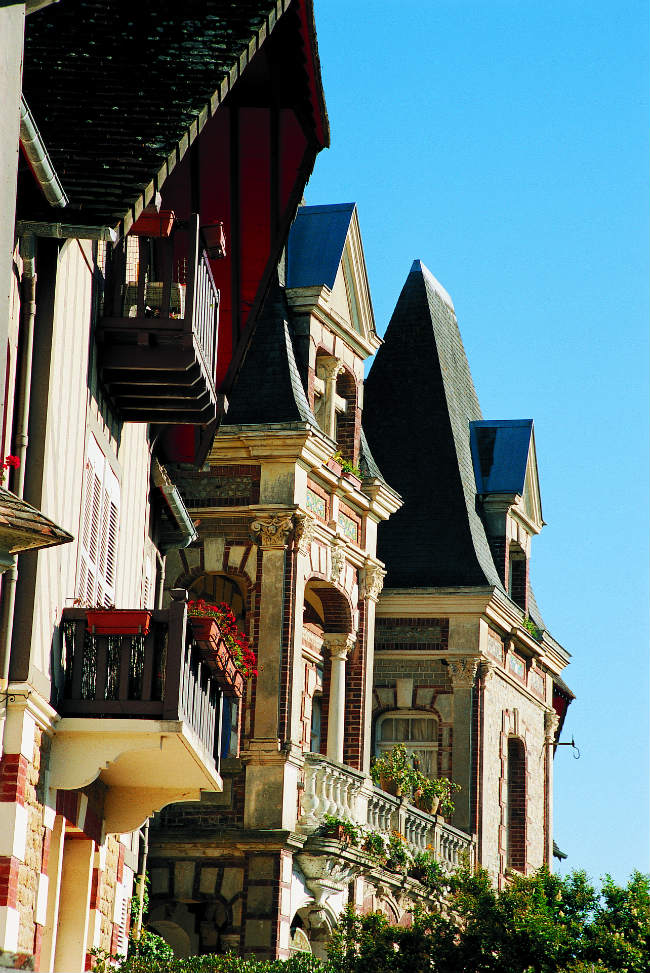
The seaside town of Cabourg. Photo: Corlet/ OT Cabourg
HUMAN CANNONBALLS
Bastions of Belle-Époque charm, festooned with a rainbow of extravagant, mosaic-speckled Neo-Norman villas, these seaside resorts were (and still are) the ultimate fashionable destination and lured Paris’s beau monde as early as the 1860s, mainly to partake in the latest medical fad of the bains de mer. To the blissfully ignorant (ahem, me), the innocuous-sounding ‘sea baths’ conjure images of silk-stockinged folk lolling back in the waves, the swell gently tickling their weary glutes. Not so. The most effective, but alarmingly-named bains à la lame (blade baths) were quite an ordeal – and a spectacle – not least because in the early days local fishermen (the only people in the vicinity with a working knowledge of the doggy paddle) were enlisted to fling dainty socialites, who had never learned to swim, into the ocean. To reap the curative benefits of salt water, which was purported to heal anything from rheumatism to toothache, the drenched sirens would then hold onto a rope for dear life and splosh about.
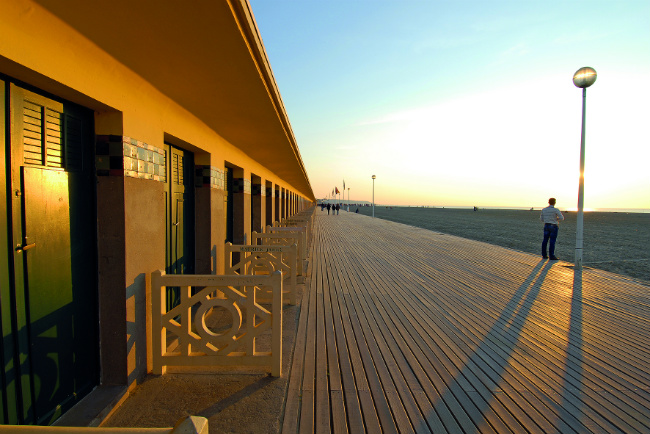
Deauville Beach. Photo: Patrice Le Bris
The human-cannon tack was mercifully short-lived. Strapping and far more gentle ‘swimming guides’ entered the scene, carrying women into the open seas (and often indulging in some hanky-panky in the process). In Luc-sur-Mer, on the Côte de Nacre, the locals are still nicknamed Lutins (derived from lutiner, literally to fondle) after their notoriously handsy lifeguards. The richest, in the early days anyway, simply waded into the open waters aboard a horse-drawn carriage-cum-mobile changing room and enjoyed a quick dip before boarding their vessel again.
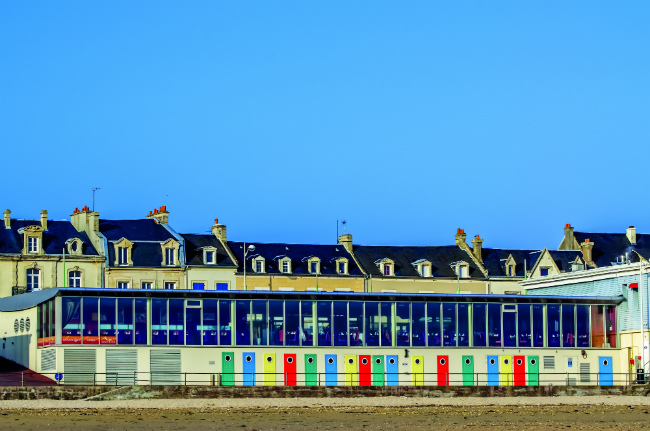
The Calvados coast is popular with summer visitors. Photo: Luc Didier Bordas
The glitterati and a posse of modish artists wasted no time in claiming these laps of luxury as their playground. Marcel Proust was especially fond of Cabourg and set up rooms in the Grand Hôtel, a jewel-box turn-of-the-century confection with all the curlicued trappings. You can visit his room, or at least one of his many rooms – the author of À la recherche du temps perdu was a notorious grump and nit-picker who switched rooms like the wind. Failing the real showroom experience, you can always console yourself by munching on a madeleine de Proust in the hotel’s swish tea rooms.
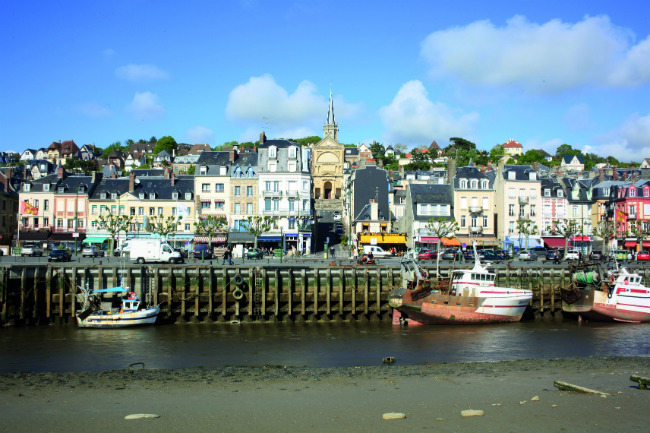
Trouville at low tide. Photo: Fotolia
Steadily, it was towards the rival resorts of the so-called Parisian Riviera – Trouville and Deauville – that most gravitated. The more understated and unfussy of the two (to this day), Trouville was favoured by the likes of Claude Monet, Eugène Boudin and Marguerite Duras, while Deauville’s heady extravagance and excess seduced a moneyed crowd of sybarites, the inevitable slew of upstarts and trendsetters. In fact, it is here, a hop and a skip from the boardwalk where Coco Chanel launched her first fashion boutique and revolutionised womenswear, eschewing restrictive corseted silhouettes for looser- fitting beach apparel. It is said that her trademark beige hue was inspired by the wave-lapped sand, while her Breton-stripe shirts and trousers were an elevated take on sailors’ kit.
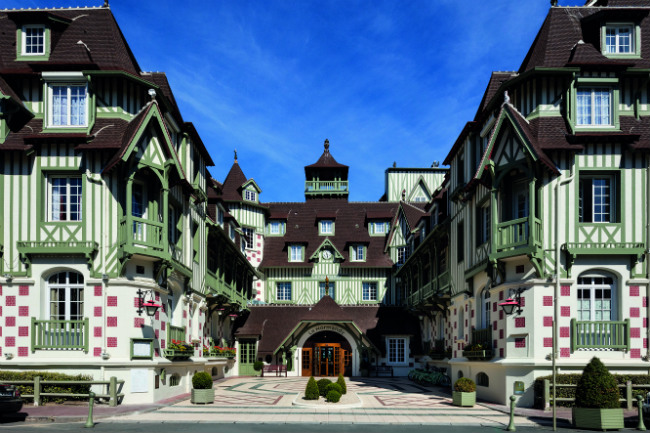
courtesy of the Normandy Hotel Barrière
Today, the resort is the hangout of an altogether different breed: Hollywood A-listers, thanks to the American Film Festival, which thrust the Parisian Riviera under Tinseltown’s radar in the 1970s. Needless to say, the station balnéaire is popular with those keen to catch a glimpse of these demi-gods in their natural habitat. The best place for a spot of selfie-chasing is the renowned Les Planches boardwalk. Decked with Art Deco cabins named after past festival laureates and acting royalty – Sean Connery and Elizabeth Taylor chief among them – the star-studded promenade is Deauville’s answer to the Hollywood Walk of Fame. One name you won’t find, though, is Harvey Weinstein, who was quickly wiped from the line-up at the tail end of last year. Even at his go-to haunt in nearby Trouville, Les Quatre Chats (quite the anachronistic medley of red club lighting, vinyl banquettes and Formica a stone’s throw from the old fish market) his grinning mug is nowhere to be seen. The ‘wall of fame’ has not lost its pizazz, however, with Matt Damon, Gwyneth Paltrow and a merry-looking Andy Garcia filling the space quite nicely.
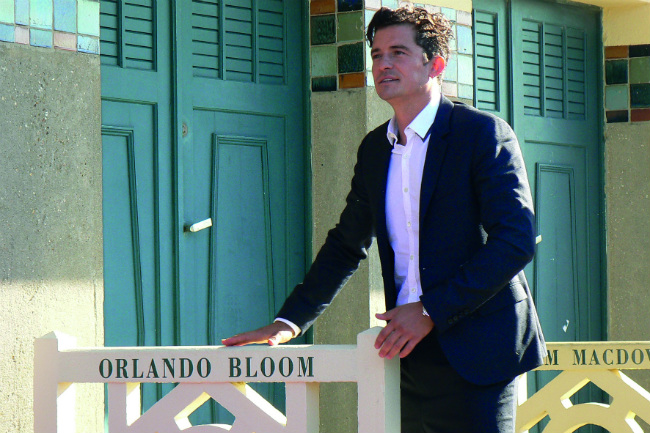
Orlando Bloom at the Festival du Cinéma Américain. © Ville de Deauville
“I remember when Matt Damon first came,” recalls owner Serge Salmon; in his own way the custodian of the resort’s (modern) legacy. “We didn’t know him then; it was after the first Jason Bourne and he looked about 16. He came with six people, had a quiet dinner. The following year he booked a whole floor; the one after that he booked the whole place.” To be fair, Mr Damon looks pretty fresh-faced in the snaps. But Serge keeps shtum about the identity of some of his most recent patrons, only volunteering that someone “as big as Madonna” recently visited the American-style dinner. “Elton John?” I chance. “Ben Affleck? Trump! No? Guillaume?” I tease. It seems I’ve used up all my guesses and our group is swiftly ushered to Les Quatre Chats’ cocktail bar across the street for an apéro.
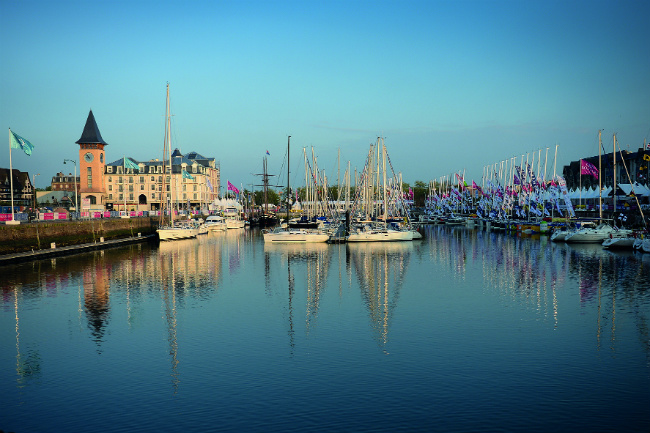
The Bassin Morny at Deauville. Photo: Sandrine Boyer Engel
Sipping my petit blanc, I picture Coco Chanel swanning in, William in tow, plonking his lance by the door, soldiers filing past on their march to freedom and the indomitable Mme Hoffer bringing up the rear, like guests to the barmiest of fantasy dinner parties.
“We must keep our past alive,” her parting words dance around my mind. “If we don’t, who else will?” Who indeed.
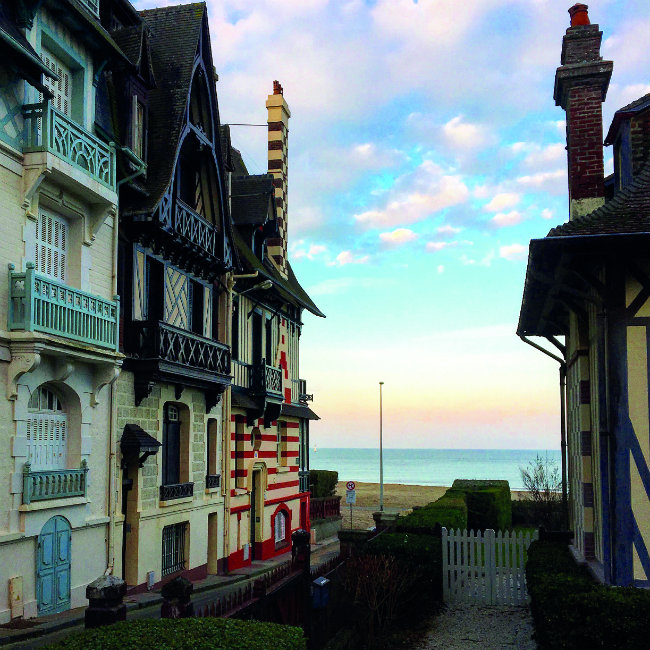
Trouville at sunset. Courtesy of the Office de Tourisme
A TASTE OF CALVADOS
Let’s start with two Cs: cider and Calvados. As a rule of thumb, drive about 10km in any direction and you’ll stumble across a cider farm or Calvados distillery. An exciting recent launch was the one-stop shop Calvados Experience in Pont-l’Évêque, a centre entirely dedicated to the history of the smooth apple brandy, with dégustations to boot. While you’re in town, try Pont-l’Évêque’s eponymous, and oh-so moreish, cheese. Lovers of the stinky stuff should also put Livarot at the top of their list. A word of warning though: as fromage goes it is denitely on the pungent side of the spectrum. Keep the fridge door shut.
If you really wish to test your palate and mettle why not give tripes à la mode de Caen – innards (and veggies) stewed in cider and apple brandy – a chomp? The sweet-toothed should pop over to the Côte de Nacre for a taste of the famous sablés d’Asnelles, rich butter biscuits produced in the little nook since 1904.
This neck of the woods is also home of the gui-gui, a naturally-flavoured marshmallow lollipop. For the best around, head to La Gui-Gui de Luc in Luc-sur-Mer. Owners Jordy and Sam have promised France Today readers a free gui-gui, so make sure to pack a copy! Seafood ends should head for Aux Régals de l’Île oysters in Courseulles-sur-Mer.
From France Today magazine
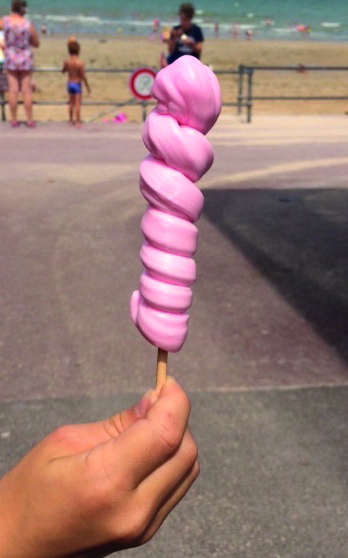
The “gui-gui” lollipop. Photo: Marion Sauvebois
Share to: Facebook Twitter LinkedIn Email
Leave a reply
Your email address will not be published. Required fields are marked *

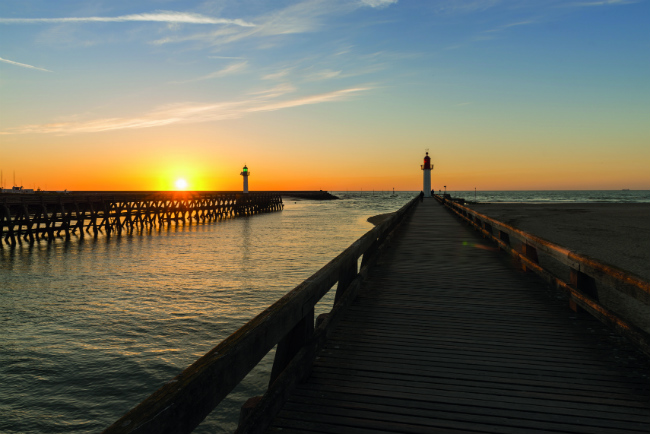




REPLY